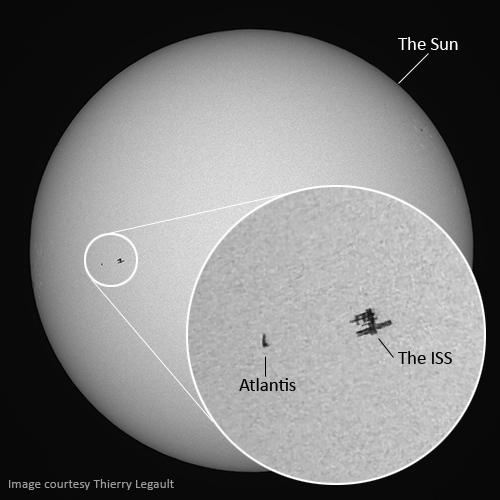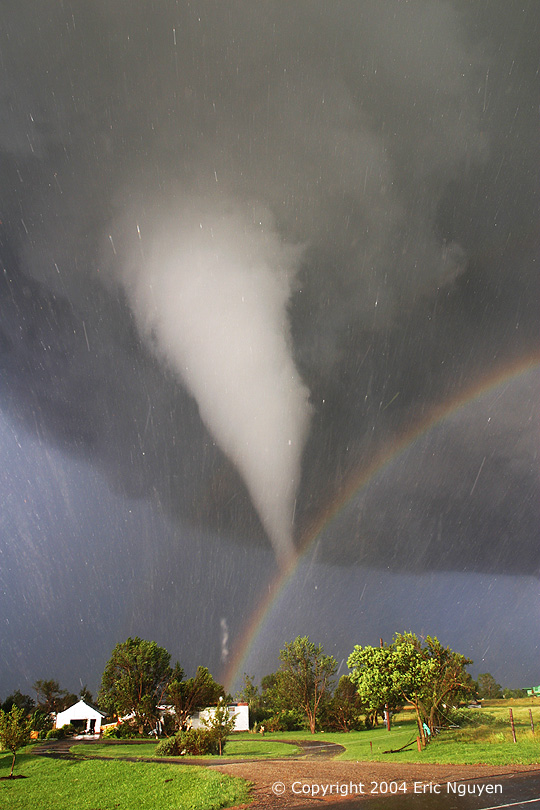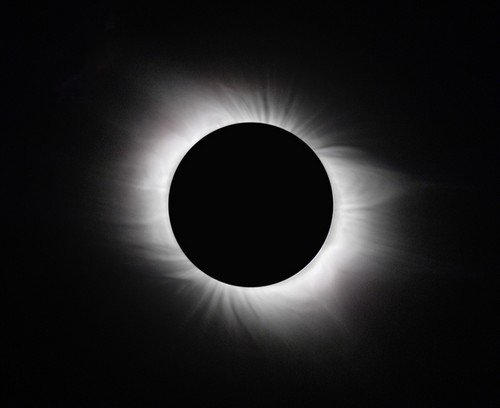Breathtaking Möbius structure revealed in 4 dimensions
Simply breathtaking…
Simply breathtaking…
I finally saw a blog post that provides me with an opportunity to explain why I feel that most if not all time travel stories are unrealistic (hah!).
The original post was made by the Bad Astronomer and he links to a cool website which let’s you calculate how far you move (on the Earth, in space) in a given time period: www.earthmove.info.
“My old friend and evil twin Richard Wiseman came up with a funny idea: if you were to add up all the motions of the Earth over a given period of time, how far would it have moved?
Lessee: it spins at 1000 mph at the Equator (don’t forget to compensate for latitude), it orbits the Sun at 18 miles per second, the Sun orbits the Galactic center at about 200 mps, and the Galaxy is moving toward th Andromeda Galaxy while simultaneously falling into a massive cluster of galaxies called The Great Attractor. Oh — the Universe is expanding, with the visible edge receding from us (or equally, we are receding from it) at the speed of light.”
So, how does this relate to time travel? Let’s say that if you went back in time a single minute and your time machine was located in a comfortable laboratory in Midtown New York, you would be instantly transported 11,018,000 miles away. Rather, you would be in the same spot and the Earth would be 11,018,000 miles away, where it was 1 minute ago.
So, a proper time machine would also be equipped with rockets and lots and lots of fuel. This way, once you find yourself in deep space (one minute ago), you can start heading back to Earth. Even so, to travel 11MM miles at the speed of light (or close to it, ignoring acceleration and deceleration) still takes like a minute or something. So, by the time you got back to Earth, you’d be back where you started. Oh, but not really. Since you’d be warping space-time traveling at relativistic speeds like that… Earth would likely be 100 years in the future once you got there.
When you arrive, people will wonder where you were all this time and won’t believe you when you claim to have gone BACK in time.
An alternative time machine that might solve all of these problems might be more like a time dilator and a transporter all wrapped up in one. So, you can not only go back in time, but the machine will calculate the crazy looping trajectories needed to get you to exactly the same spot on Earth one minute ago. This could be dangerous, of course, since you might miscalculate and fuse with the Earth’s core. Geez, couldn’t you also fuse with air molecules when you appear? Perhaps all of this is most safely done in a vacuum. Anyway, you better have a computer with a lot of significant digits in it’s floating point processor.
Round-off error could be a problem otherwise.
-n
It’s not often that I get to tag a blog entry with the beer AND science categories, but here it goes.
A colleague of mine sent a very cool video of a beer freezing instantly, by merely tapping it on a counter. Of course, the beer was super-freezed by a liquid nitrogen bath.
Now, not everyone has liquid nitrogen laying around the home. However, if you have a lime, you can do a similar experiment. Here are the steps.
While you wait for the Corona to thaw, go grab a good Belgian beer and perhaps you’ll forget about that Corona. Note that a good beer does not require a lime.
My only explanation for this is that the freezing temperature of beer is below that of water. So, the water from the lime hits the colder-than-freezing alcohol and causes the water to freeze.
Thanks John for the and thanks Jen for the correction. Of course Liquidnet nitrogen would not lock up a beer, as it would only promote flow ;-)
The Register ran an article on a freaky miniaturized mountain range complete with intricate detail of “lakes, valleys and snow-capped peaks.”
Whoa! I wonder if they fly mini-helicopters over that and film it. That would be so cool.
Oh, it's probably a military model, of course:
Don't, however, spend the next three days scouring the world's mountain ranges trying to find a geographical match: the legwork has already been done for you by this enterprising Google Earth Community member who correctly identified the model as representing this disputed area on the Chinese/Indian border.
(Link)
I just saw this picture come across over at the Astronomy Picture of the Day. Consider it for a moment:
Explanation: The Great Spiral Galaxy in Andromeda (aka M31), a mere 2.5 million light-years distant, is the closest large spiral to our own Milky Way. Andromeda is visible to the unaided eye as a small, faint, fuzzy patch, but because its surface brightness is so low, casual skygazers can't appreciate the galaxy's impressive extent in planet Earth's sky. This entertaining composite image compares the angular size of the nearby galaxy to a brighter, more familiar celestial sight. In it, a deep exposure of Andromeda, tracing beautiful blue star clusters in spiral arms far beyond the bright yellow core, is combined with a typical view of a nearly full Moon. Shown at the same angular scale, the Moon covers about 1/2 degree on the sky, while the galaxy is clearly several times that size. The deep Andromeda exposure also includes two bright satellite galaxies, M32 and M110 (bottom).
Even with the darkest skies, you would never see the Andromeda galaxy like this without a largish telescope and/or an extended exposure on film or a digital camera. Now, though, due to light pollution, most urban and suburban skygazers can’t even get these views with their telescopes.
Anyway, this image certainly put things into perspective for me.
 I’ve linked to Phil Plait’s Bad Astronomy Blog a few times before. That’s how I was turned onto xkcd. I love his physics-oriented movie reviews, like this one of Superman Returns (and lots more). One day I’ll read his book, Bad Astronomy: Misconceptions and Misuses Revealed, from Astrology to the Moon Landing 'Hoax'.
I’ve linked to Phil Plait’s Bad Astronomy Blog a few times before. That’s how I was turned onto xkcd. I love his physics-oriented movie reviews, like this one of Superman Returns (and lots more). One day I’ll read his book, Bad Astronomy: Misconceptions and Misuses Revealed, from Astrology to the Moon Landing 'Hoax'.
 For now, he’s asked for some support for a hokey Weblog Award that he really deserves. So, unles you have some other favorite science blog, make your way over to the voting page and vote for the BABlogger!
For now, he’s asked for some support for a hokey Weblog Award that he really deserves. So, unles you have some other favorite science blog, make your way over to the voting page and vote for the BABlogger!
Oh, if you don’t believe that we landed on the moon then you can forget about all of this.
Someone sent this to me, and like him, I could not stop laughing.
"Spirit has been displaying some anomalous behavior," said Project Manager John Callas, who noted the rover's unsuccessful attempts to flip itself over and otherwise damage its scientific instruments. "And the thousand or so daily messages of 'STILL NO WATER' really point to a crisis of purpose."
(reported by the Onion, link)
From EPOD:
The Cork Oak (Quercus suber) is one of the species of trees that has its bark “harvested” to produce the variety of objects that we use in our daily lives. Things like “corks” for wine bottles, floor tiles, wallboards, gaskets, coasters and sporting equipment, to name a few. The unique properties of natural cork are primarily the result of its specialized structure -- it's bark is composed of tiny cells, each a 14-sided polyhedron, with the intercellular space entirely filled with air. There are approximately 40 million of these cells in a single cubic centimeter of cork bark.
Cork is lightweight, rot resistant, compressible and expandable, fire resistant, impermeable, soft and buoyant too. It has been used for thousands of years by the Egyptian, Greek and Roman cultures. Cork oaks grow best in the Mediterranean climate of Portugal, Spain and Northern Africa. The commercial “stripping” of bark is tightly controlled to ensure a continued harvest of this valuable natural resource. The first bark is not harvested from a tree until it's 25-years old and then only every nine years afterward, on a rotating basis. This process allows a tree to be harvested for over 200 years. The cork is peeled off in large panels from the main sections of the trunk, including the large branches. About a third of the bark can be harvested from the tree at one time.
The above picture was taken of a tree that had been previously harvested and was in the process of growing new bark. This self-portrait was taken on a trip to southern Portugal in January of 2004. Portugal accounts for over 50% of the world’s cork production. While traveling through the Portuguese countryside it was hard not to notice these exceptional and highly prized trees.
(Link)
You may hate me for making you sit through that, but now you know where corks come from.

"These are conditions that regulations never envision," says Dave Minnaar, radiological expert with Michigan's Department of Environmental Quality. "It's simply presumed that the average person wouldn't have the technology or materials required to experiment in these areas."
Read the account, which happened way back in 1995. A Brilliant teenager’s step-by-step journey toward a working nuclear reactor.
Whoa.
I also found this note very interesting:
Note: This article is being reprinted here as an example of what NOT to do with radioactive materials. Please do NOT attempt to recreate any part of these experiments for the following reasons:
You will most likely poison yourself and/or others
Nobody really needs an unsafe homemade reactor (especially one made of duct tape and foil)
If enough people try these dangerous experiments, the government will try to outlaw any sort of legitimate private experiments with radioactivity or possession of any radioactive minerals or materials (thus spoiling all of our fun).
Fun?
From spaceweather.com:
Yesterday, the space shuttle Atlantis undocked from the International Space Station (ISS). Amateur astronomer Thierry Legault caught the two spaceships separating directly in front of the sun.

I created this graphic, but I hope I’m allowed to do so. I didn’t see any kind of copyright on the image linked on spaceweather.com’s website.
When you’re looking at photos of star trails, many people overlook the fact that they can usually hide some interesting details.
On the surface, this photo called Gemini South Star Trails is just another pretty picture. However, if you look closely you’ll see two smudges in the photo and one streak going against the grain of the photo next to the observatory.
The next time you look at these long-exposure photos, look for some of these details.
Stars seem to arc through southern skies in this surrealistic time exposure -- recorded before moonrise from the Gemini South Observatory, Cerro Pachon, Chile, Planet Earth. During the one hour 40 minute exposure camera and tripod were fixed, so the concentric star trails are a reflection of Earth's daily rotation about its axis. The view looks to the south and includes the Gemini telescope enclosure in the foreground. At the apparent center of the curving trails, the South Celestial Pole lies just off the upper left edge. Two faint, wide streaks track the Magellanic Clouds, satellites of the Milky Way Galaxy, while a meteor flashes throught the scene just left of the observatory.
(Link)
If you read my blog, you know that I’m interested in Astronomy. I’ve made lots of posts on Astronomy over the years. I’ve even made my own crappy movies using some of the software I use, Starry NIght Pro:
So, many of you may know about the recent turmoil over Pluto (cartoons here). Well, the BBC news has an article that describes the recent naming of the bastard planet, er. Dwarf Planet, which started all of the trouble. Meet Eris:
The distant world whose discovery prompted leading astronomers to demote Pluto from the rank of "planet" has now been given its own official name.
Having caused so much consternation in the International Astronomical Union (IAU), the object has been called Eris, after the Greek goddess of discord.
Eris is larger than Pluto, which put scientists in the fix of having to call them both planets - or neither.
Both bodies have now been put in the new classification of "dwarf planets".
Eris' discoverer, Michael Brown of the California Institute of Technology, told the Associated Press that the name was an obvious choice, calling it "too perfect to resist".
In mythology, Eris caused a quarrel among goddesses that sparked the Trojan War. In real life, Eris also caused strife, forcing scientists to produce a strict definition of the term planet - and that eventually led to Pluto losing the status it had held since its discovery in 1930.
The need for a strict definition was deemed necessary after new telescope technologies began to reveal far-off objects that rivalled Pluto in size.
The Bad Astronomer himself rants about the common misunderstanding about these two commonly confused forces. Best explanation, ever.
In various places on my site and in this blog, I have mentioned centrifugal force. Invariably when I do so, someone pedantically comes along and says "That’s not a real force! It’s fictional! It’s really just centripetal force".
Let me clear and blunt here: that’s wrong. Centrifugal force is every bit as real as centripetal force. It’s just in a different frame. "Centripetal" means "center-seeking", and "centrifugal" means "outwards-seeking" or, more literally, "center-fleeing". You’d think these are opposites, but they are in fact the same thing! It just depends on your point of view.
If you are standing outside a spinning object, and then draw a diagram of the forces, yes, you’re better off using centripetal force. The math works out more easily. But if you’re on that spinning object, then the forces are easier to draw assuming a centrifugal force. Really!
Think of it this way: watch a car make a right turn. The people inside have inertia, and they "want" to stay moving forward. The car pushes them to the right, toward the center of the circle it is making. Centripetal.
Now sit inside that car. When the car turns right, which way do you feel yourself leaning? Toward the left, away from the center. You feel a force towards the outside of the circle.
Tadaaa! Same thing, different viewpoints.
Centripetal = centrifugal. Got it? They’re the same thing. If one is real, then so’s the other. Once more, just to make sure:
Centripetal = centrifugal.
Cripes, I hope I don’t ever have to explain that again. If I run across this non-issue again, I will link the perpetrator to this page and make them read it three times.
And if you don’t get it, don’t feel bad. James Bond didn’t either.
(Link)
From what I understand, this has never been seen before:
In order for a Uranian transit to occur, the Sun must shine directly over the giant planet's equator; the next time this will happen again is in 2007. The last time such a Uranian equinox occurred was in 1965, but telescopes at the time were not sharp enough to view the transits.
The shadow cast by a moon as it drifted through space above the blue-green cloud tops of Uranus was recently captured for the first time by NASA's Hubble Space Telescope.
To an observer on Uranus, the passage of the planet's icy moon Ariel would have appeared as a solar eclipse and the Sun would be completely blotted out. However, the effect would not be nearly as dramatic as a total eclipse involving Earth and its moon. The Sun appears much smaller on Uranus than on Earth because the giant planet is located much further away. Therefore, a total eclipse involving its moon completely blocks out not only the Sun's body, but also its corona.
From my astronomy club, from the Australian Antartic Division, here is an article talking about these rare and colorful clouds found only in the most extreme cold cold environments:
These so-called nacreous clouds were situated high in the stratosphere, some 20km above the ground, and reveal very cold temperatures in the rarefied atmosphere.
Photographs taken by Renae Baker, a meteorological officer with the Australian Bureau of Meteorology at Mawson, on July 25 show delicate colours produced when the fading light at sunset passed through tiny water-ice crystals blown along on a strong jet of stratospheric air.
"Spectacular is an understatement. The clouds were such a special and welcoming sight now that the sun has just started to return near the end of winter. I am keeping my eyes towards the celestial dome and camera at the ready in the hope of some more."
"Our weather balloon measured temperatures down to -87ºC in the vicinity of the cloud layer. That's about as cold as the lowest temperatures ever recorded on the surface of the Earth. Amazingly, the winds at this height were blowing at nearly 230 kilometres per hour," Ms Baker said.
Clouds this spectacular are seldom seen.
You can find an entire photo gallery here:
Saw this come across my astronomy club’s mailing list. From the BP Kongsberg Underwater Image Competition 2006.

Some of the microscopic images found here are frightening. Check out the other categories. Some of the creatures have fantastic shapes. Check out thess awesome structures.


From APOD:
Explanation: The scene might have been considered serene if it weren't for the tornado. Last June in Kansas, storm chaser Eric Nguyen photographed this budding twister in a different light -- the light of a rainbow. Pictured above, a white tornado cloud descends from a dark storm cloud. The Sun, peeking through a clear patch of sky to the left, illuminates some buildings in the foreground. Sunlight reflects off raindrops to form a rainbow. By coincidence, the tornado appears to end right over the rainbow. Streaks in the image are hail being swept about by the high swirling winds. Over 1,000 tornadoes, the most violent type of storm known, occur on Earth every year, many in tornado alley. If you see a tornado while driving, do not try to outrun it -- park your car safely, go to a storm cellar, or crouch under steps in a basement.

The japanese video (narration in Japanese) of a very large meteor hitting the Earth. I’m posting this to see if I can yet a Yutube video playing in my blog,mostly.
I first heard of this on my astronomy club’s mailing list, the link was here.
I think a real meteor, or asteroid, would not be so molten. It would likely be a piece of cold rock. Or, it would be an icy comet.
Enjoy the end of the world.
I thought this was pretty cool. Black Sun in Denmark, from Earth Science Picture of the Day:
During spring in Denmark, at approximately one half an hour before sunset, flocks of more than a million European starlings (sturnus vulgaris) gather from all corners to join in the incredible formations shown above. This phenomenon is called Black Sun (in Denmark), and can be witnessed in early spring throughout the marshlands of western Denmark, from March through to the middle of April. The starlings migrate from the south and spend the day in the meadows gathering food, sleeping in the reeds during the night. The best place to view this amazing aerial dance is in the place called "Tøndermarsken," where these pictures were taken (on April 5 from 19.30 to 20.30 local time).
I promise these will stop soon, but this shot was too spectacular to pass up:
Pete Lawrence is fixated on Earthshine - the faint illumination of the dark hemisphere of the Moon by light bounced off Earth. Earlier this month he mosaicked two exposures to make a composite image clearly showing both the sun-lit and Earth-lit secments. Today he combines four exposures to capture the maximum possible Earthshine. Here is his explanation: When the Moon is new from the Earth, the Earth is full from the Moon. The light from the full Earth faintly illuminates the Moon making the new Moon visible against a dark sky. For the most part the sky is way too bright to see this effect. However, at the time of a total eclipse of the Sun, it is possible to capture this phenomenon. This image was taken during March 29 solar eclipse totality from ~20km to the east of Side, Turkey. It’s a composite of four images 1/350s, 1/30s, 1/20s and 1/3s. This is Chuck again: This is maximum Earthshine because an entire terrestrial hemisphere is reflecting light to the Moon, and the entire dark lunar hemisphere is illuminated. Normally Earthshine is viewed when the Moon is 2-3 days past new (and only part of the visible Moon is in Earthshine) and when the Earth is no longer full (and only part of its reflected light hits the Moon).
(Link to LPOD)
Holey moley this is cool. That's it, the next solar eclipse will see me on a plane wherever the totality takes me!
This is just awesome.

(Courtesy Joel Moskowitz & Glenn Schneider)
From Astronomy.com:
An occultation of the Pleiades star cluster (M45) by the Moon will occur during the evening of 2006 APR 01 (Saturday) and will be a nighttime event across the eastern half of North America and northwestern South America.
Since the crescent Moon’s apparent disk will be only 17% illuminated, this will make for a better photographic event than its immediate predecessors in this series. Additionally, the fact that the Moon will be waxing will enhance the ability to observe immersions (disappearances) of individual stars. This should be the finest opportunity for observers in eastern North America during the entire 2005-10 Pleiades occultation series.
The Pleiades are a beautiful cluster of stars that a lot of people think is the little dipper, since it looks a little bit like it. However, the Pleiades are 2–3 times as long as the moon and not nearly the size of the actual Little Dipper in the sky.
This should be an awesome site, especially if you have some binoculars. Someone in my astronomy club offered up this star occultation for New York (times are in EST):
Disappears Reappears
25 Alcyone 7:54 p.m. 8:55 p.m.
27 Atlas 8:40 p.m. 9:31 p.m.
17 Electra 6:44 p.m. 7:45 p.m.
20 Maia No occultation
23 Merope 7:24 p.m. 8:19 p.m.
19 Taygeta No occultation
28 Pleione 8:39 p.m. 9:36 p.m.
Watch for it tomorrow night!
More information on this morning’s eclipse and an archived webcast of the event can be found on spaceweather.com.
Tomorrow, there will be a total solar eclipse. Various blogs report on it but here is a richly detailed description of the event:
On Wednesday, 29th March 2006, the shadow of the Moon will sweep a band starting from Brazil, through Atlantic Ocean, Gold Coast of Africa, Saharan Desert, Mediterranean Sea, Turkey, Black Sea, Georgia, Russian Federation, northern shores of Caspian Sea, Kazakhstan; ending in Mongolia. The duration of totality will be less than 2 minutes near the sunrise and sunset limits, but will be as long as 4 minutes and 7 seconds in Libya, at the moment of greatest eclipse. The path of totality will be 180 kilometers wide at that moment.
NASA has an amazingly detailed graphic:
I simulated the eclipse, as experienced by an observer at these coordinates, using Starry Night astronomy software:
35 17.0N 029 20.2E
At precisely 10:52 Universal Time.
Notice the Iridium 31 satellite that passes by? I wonder if observers will notice that? I wasn’t completely happy with the simulation, by the way. The moon never passes over the sun. Instead, there is some kind of instantaneous shutter effect instead. Watch it and let me know what you think.
A guy from our local astronomy club, just last week, decided to book a flight to Turkey and head off to the totality. His wife was like, “Just go!” as he hemmed and hawed about the opportunity. He wrote an e-mail today saying he had arrived in Turkey and was with many other eclipse enthusiasts. I hope the weather holds out for them.
Clear skies.
On March 6th, the interplanetary magnetic field (IMF) tipped south, opening a crack in Earth's magnetosphere. Solar wind flowed in and bright auroras appeared over Scandinavia.
I should have posted this last week. You can check out more pictures at the spaceweather.com website. Here are a few nice ones. I swear if I saw this in the sky I would run away like a little girl.